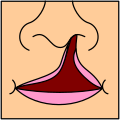മുച്ചുണ്ടും മുറിയണ്ണാക്കും
ജൻമനായുള്ള രൂപവൈകല്യങ്ങളിൽ ഒന്നാണ് മുച്ചുണ്ടും മുറിയണ്ണാക്കും. ചുണ്ടുകൾക്കുണ്ടാകുന്ന ഒരു പ്രധാന വൈകല്യമാണ് മുയൽച്ചുണ്ട് (മുച്ചിറി). ഗർഭസ്ഥശിശുവിൽ അഞ്ചുഭാഗങ്ങളായി രൂപംപ്രാപിക്കുന്ന മുഖത്തിന്റെ ചില ഭാഗങ്ങൾ തമ്മിൽ കൂടിച്ചേരാതെവരുമ്പോഴാണ് മുയൽച്ചുണ്ട് ഉണ്ടാകുന്നത്. ഒരു വശത്തു മാത്രമായോ രണ്ടു വശത്തുമായോ ഈ വൈകല്യം ഉണ്ടാകാം. മുച്ചിറിയുടെ പിളർപ്പു പൂർണമായോ അല്പമായോ ഉണ്ടാകാവുന്നതാണ്. പൂർണമായ പിളർപ്പുള്ള കുട്ടികളുടെ മൂക്ക് പരന്നും നാസികാദ്വാരം വായോടുചേർന്നും ഇരിക്കും. ഇങ്ങനെയുള്ള പല കുട്ടികളുടെയും അണ്ണാക്കും പിളർന്നിരിക്കും (Cleft Palate). ഇവർ ആഹാരം കഴിക്കുമ്പോൾ അതിലൊരംശം മൂക്കിൽകൂടി പുറത്തേക്കു വരിക സാധാരണയാണ്. വായുടെ വലിപ്പം അധികമാകുക, നാക്കിന്റെ അടിഭാഗം വായുമായി കൂടിച്ചേരുക (tongue tie) ഇവയാണ് വായിൽ ഉണ്ടാകാറുള്ള വൈകല്യങ്ങൾ.
| മുച്ചുണ്ടും മുറിയണ്ണാക്കും | |
|---|---|
| സ്പെഷ്യാലിറ്റി | Medical genetics |
ലക്ഷണങ്ങളും അടയാളങ്ങളും
തിരുത്തുകIf the cleft does not affect the palate structure of the mouth it is referred to as cleft lip. Cleft lip is formed in the top of the lip as either a small gap or an indentation in the lip (partial or incomplete cleft) or it continues into the nose (complete cleft). Lip cleft can occur as a one sided (unilateral) or two sided (bilateral). It is due to the failure of fusion of the maxillary and medial nasal processes (formation of the primary palate).
-
ഏകപക്ഷീയമായി അപൂർണ്ണമായത്
-
ഏകപക്ഷീയമായി പൂർണ്ണമായത്
-
ഇരുപക്ഷീയമായി പൂർണ്ണമായത്
A mild form of a cleft lip is a microform cleft.[1] A microform cleft can appear as small as a little dent in the red part of the lip or look like a scar from the lip up to the nostril.[2] In some cases muscle tissue in the lip underneath the scar is affected and might require reconstructive surgery.[3] It is advised to have newborn infants with a microform cleft checked with a craniofacial team as soon as possible to determine the severity of the cleft.[4]
-
Six-month-old girl before going into surgery to have her unilateral complete cleft lip repaired
-
The same girl, 1 month after the surgery
-
The same girl, age 8, the scar almost gone
അവലംബങ്ങൾ
തിരുത്തുക- ↑ Kim EK, Khang SK, Lee TJ, Kim TG (May 2010). "Clinical features of the microform cleft lip and the ultrastructural characteristics of the orbicularis oris muscle". Cleft Palate Craniofac. J. 47 (3): 297–302. doi:10.5555/08-270.1. PMID 19860522. Archived from the original on 2021-04-14. Retrieved 2016-03-26.
{{cite journal}}: Check|doi=value (help)CS1 maint: multiple names: authors list (link) - ↑ Yuzuriha S, Mulliken JB (November 2008). "Minor-form, microform, and mini-microform cleft lip: anatomical features, operative techniques, and revisions". Plast. Reconstr. Surg. 122 (5): 1485–93. doi:10.1097/PRS.0b013e31818820bc. PMID 18971733.
- ↑ Tosun Z, Hoşnuter M, Sentürk S, Savaci N (2003). "Reconstruction of microform cleft lip". Scand J Plast Reconstr Surg Hand Surg. 37 (4): 232–5. doi:10.1080/02844310310016412. PMID 14582757.
{{cite journal}}: CS1 maint: multiple names: authors list (link) - ↑ Tollefson TT, Humphrey CD, Larrabee WF, Adelson RT, Karimi K, Kriet JD (2011). "The spectrum of isolated congenital nasal deformities resembling the cleft lip nasal morphology". Arch Facial Plast Surg. 13 (3): 152–60. doi:10.1001/archfacial.2011.26. PMID 21576661. Archived from the original on 2012-03-23. Retrieved 2016-03-26.
{{cite journal}}: CS1 maint: multiple names: authors list (link)





